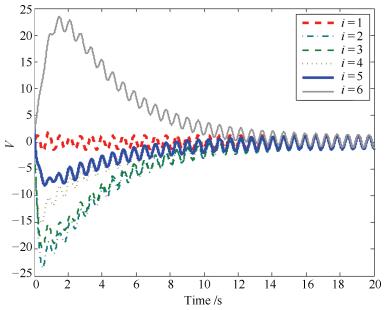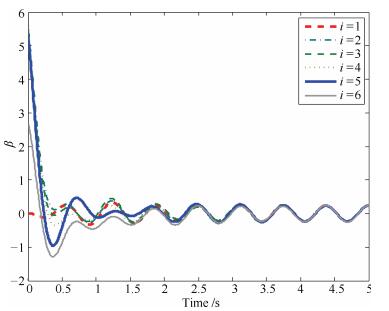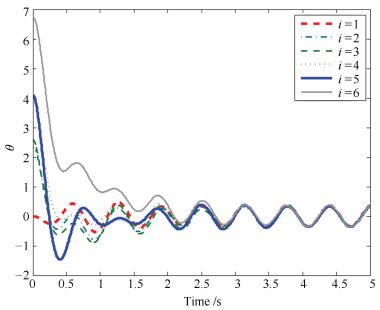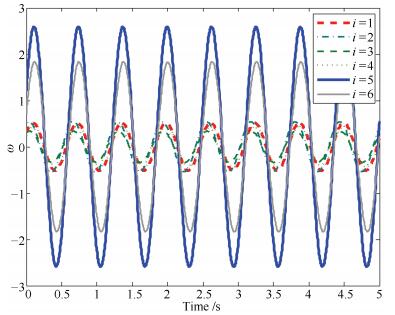|
[1]
|
闵海波, 刘源, 王仕成, 孙富春.多个体协调控制问题综述.自动化学报, 2012, 38(10):1557-1570 http://www.aas.net.cn/CN/abstract/abstract17765.shtmlMin Hai-Bo, Liu Yuan, Wang Shi-Cheng, Sun Fu-Chun. An overview on coordination control problem of multi-agent system. Acta Automatica Sinica, 2012, 38(10):1557-1570 http://www.aas.net.cn/CN/abstract/abstract17765.shtml
|
|
[2]
|
Olfati-Saber R, Fax J A, Murray R M. Consensus and cooperation in networked multi-agent systems. Proceedings of the IEEE, 2007, 95(1):215-233 doi: 10.1109/JPROC.2006.887293
|
|
[3]
|
Ren W, Beard R W, Atkins E M. Information consensus in multivehicle cooperative control. IEEE Control Systems Magazine, 2007, 27(2):71-82 doi: 10.1109/MCS.2007.338264
|
|
[4]
|
Oh K K, Park M C, Ahn H S. A survey of multi-agent formation control. Automatica, 2015, 53:424-440 doi: 10.1016/j.automatica.2014.10.022
|
|
[5]
|
Fax J A, Murray R M. Information flow and cooperative control of vehicle formations. IEEE Transactions on Automatic Control, 2004, 49(9):1465-1476 doi: 10.1109/TAC.2004.834433
|
|
[6]
|
Olfati-Saber R. Flocking for multi-agent dynamic systems:algorithms and theory. IEEE Transactions on Automatic Control, 2006, 51(3):401-420 doi: 10.1109/TAC.2005.864190
|
|
[7]
|
Su H S, Wang X F, Lin Z L. Flocking of multi-agents with a virtual leader. IEEE Transactions on Automatic Control, 2009, 54(2):293-307 doi: 10.1109/TAC.2008.2010897
|
|
[8]
|
Yu W W, Chen G R, Gao M, Kurths J. Second-order consensus for multiagent systems with directed topologies and nonlinear dynamics. IEEE Transactions on Systems, Man, and Cybernetics, Part B (Cybernetics), 2010, 40(3):881-891 doi: 10.1109/TSMCB.2009.2031624
|
|
[9]
|
Mei J, Ren W, Chen J. Distributed consensus of second-order multi-agent systems with heterogeneous unknown inertias and control gains under a directed graph. IEEE Transactions on Automatic Control, 2016, 61(8):2019-2034 doi: 10.1109/TAC.2015.2480336
|
|
[10]
|
Wang C R, Wang X H, Ji H B. Leader-following consensus for an integrator-type nonlinear multi-agent systems using distributed adaptive protocol. In: Proceedings of the 10th IEEE International Conference on Control and Automation (ICCA). Hangzhou, China: IEEE, 2013. 1166-1171 http://ieeexplore.ieee.org/document/6564881/
|
|
[11]
|
Yu W W, Chen G R, Cao M. Some necessary and sufficient conditions for second-order consensus in multi-agent dynamical systems. Automatica, 2010, 46(6):1089-1095 doi: 10.1016/j.automatica.2010.03.006
|
|
[12]
|
梅杰, 张海博, 马广富.有向图中网络Euler-Lagrange系统的自适应协调跟踪.自动化学报, 2011, 37(5):596-603 http://www.aas.net.cn/CN/abstract/abstract17395.shtmlMei Jie, Zhang Hai-Bo, Ma Guang-Fu. Adaptive coordinated tracking for networked Euler-Lagrange systems under a directed graph. Acta Automatica Sinica, 2011, 37(5):596-603 http://www.aas.net.cn/CN/abstract/abstract17395.shtml
|
|
[13]
|
Tuna S E. Synchronizing linear systems via partial-state coupling. Automatica, 2008, 44(8):2179-2184 doi: 10.1016/j.automatica.2008.01.004
|
|
[14]
|
Scardovi L, Sepulchre R. Synchronization in networks of identical linear systems. Automatica, 2009, 45(11):2557-2562 doi: 10.1016/j.automatica.2009.07.006
|
|
[15]
|
Li Z K, Duan Z S, Chen G R, Huang L. Consensus of multiagent systems and synchronization of complex networks:a unified viewpoint. IEEE Transactions on Circuits and Systems I:Regular Papers, 2010, 57(1):213-224 doi: 10.1109/TCSI.2009.2023937
|
|
[16]
|
Ma C Q, Zhang J F. Necessary and sufficient conditions for consensusability of linear multi-agent systems. IEEE Transactions on Automatic Control, 2010, 55(5):1263-1268 doi: 10.1109/TAC.2010.2042764
|
|
[17]
|
Li Z, Duan Z, Chen G. Dynamic consensus of linear multi-agent systems. IET Control Theory & Applications, 2011, 5(1):19-28 https://www.researchgate.net/publication/224216882_Dynamic_consensus_of_linear_multi-agent_systems
|
|
[18]
|
Zhang H W, Lewis F L, Das A. Optimal design for synchronization of cooperative systems:state feedback, observer and output feedback. IEEE Transactions on Automatic Control, 2011, 56(8):1948-1952 doi: 10.1109/TAC.2011.2139510
|
|
[19]
|
Mei J, Ren W, Chen J, Anderson B D O. Consensus of linear multi-agent systems with fully distributed control gains under a general directed graph. In: Proceedings of the 53rd Annual Conference on Decision and Control (CDC). Los Angeles, CA, USA: IEEE, 2014. 2993-2998 http://ieeexplore.ieee.org/xpls/abs_all.jsp?arnumber=7039849
|
|
[20]
|
Francis B A. The linear multivariable regulator problem. SIAM Journal on Control and Optimization, 1977, 15(3):486-505 doi: 10.1137/0315033
|
|
[21]
|
Ding Z T. Asymptotic rejection of general periodic disturbances in output-feedback nonlinear systems. IEEE Transactions on Automatic Control, 2006, 51(2):303-308 doi: 10.1109/TAC.2005.863523
|
|
[22]
|
Xiang J, Wei W, Li Y J. Synchronized output regulation of linear networked systems. IEEE Transactions on Automatic Control, 2009, 54(6):1336-1341 doi: 10.1109/TAC.2009.2015546
|
|
[23]
|
Su Y F, Huang J. Cooperative output regulation with application to multi-agent consensus under switching network. IEEE Transactions on Systems, Man, and Cybernetics, Part B (Cybernetics), 2012, 42(3):864-875 doi: 10.1109/TSMCB.2011.2179981
|
|
[24]
|
Andreasson M, Dimarogonas D V, Sandberg H, Johansson K H. Distributed control of networked dynamical systems:static feedback, integral action and consensus. IEEE Transactions on Automatic Control, 2014, 59(7):1750-1764 doi: 10.1109/TAC.2014.2309281
|
|
[25]
|
Lombana D A B, di Bernardo M. Multiplex PI control for consensus in networks of heterogeneous linear agents. Automatica, 2016, 67:310-320 doi: 10.1016/j.automatica.2016.01.039
|
|
[26]
|
Yang H Y, Zhang Z X, Zhang S Y. Consensus of second-order multi-agent systems with exogenous disturbances. International Journal of Robust and Nonlinear Control, 2011, 21(9):945-956 doi: 10.1002/rnc.v21.9
|
|
[27]
|
Ding Z T. Consensus disturbance rejection with disturbance observers. IEEE Transactions on Industrial Electronics, 2015, 62(9):5829-5837 doi: 10.1109/TIE.2015.2442218
|
|
[28]
|
Godsil C, Royle G F. Algebraic Graph Theory. New York: Springer, 2001
|
|
[29]
|
Ren W and Cao Y C. Distributed Coordination of Multi-Agent Networks: Emergent Problems, Models, and Issues. London, UK: Springer-Verlag, 2011.
|
|
[30]
|
Ding Z T. Adaptive consensus output regulation of a class of nonlinear systems with unknown high-frequency gain. Automatica, 2015, 51:348-345 doi: 10.1016/j.automatica.2014.10.079
|
|
[31]
|
Liu L. Adaptive cooperative output regulation for a class of nonlinear multi-agent systems. IEEE Transactions on Automatic Control, 2015, 60(6):1677-1682 doi: 10.1109/TAC.2014.2360023
|
|
[32]
|
Guo L, Chen W H. Disturbance attenuation and rejection for systems with nonlinearity via DOBC approach. International Journal of Robust and Nonlinear Control, 2005, 15(3):109-125 doi: 10.1002/(ISSN)1099-1239
|
|
[33]
|
Wang C Y, Zuo Z Y, Sun J Y, Yang J, Ding Z T. Consensus disturbance rejection for Lipschitz nonlinear multi-agent systems with input delay:a DOBC approach. Journal of the Franklin Institute, 2017, 354(1):298-315 doi: 10.1016/j.jfranklin.2016.09.019
|
|
[34]
|
Isidori A. Nonlinear Control Systems. Berlin Heidelberg: Springer-Verlag, 1995.
|
|
[35]
|
Zheng Y F, Zhang C S, Evans R J. A differential vector space approach to nonlinear system regulation. IEEE Transactions on Automatic Control, 2000, 45(11):1997-2010. doi: 10.1109/9.887623
|
|
[36]
|
Gu Y, Seanor B, Campa G, Napolitano M R, Rowe L, Gururajan S, et al. Design and flight testing evaluation of formation control laws. IEEE Transactions on Control Systems Technology, 2006, 14(6):1105-1112 doi: 10.1109/TCST.2006.880203
|




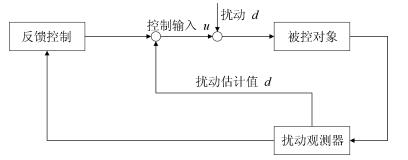
 下载:
下载:
